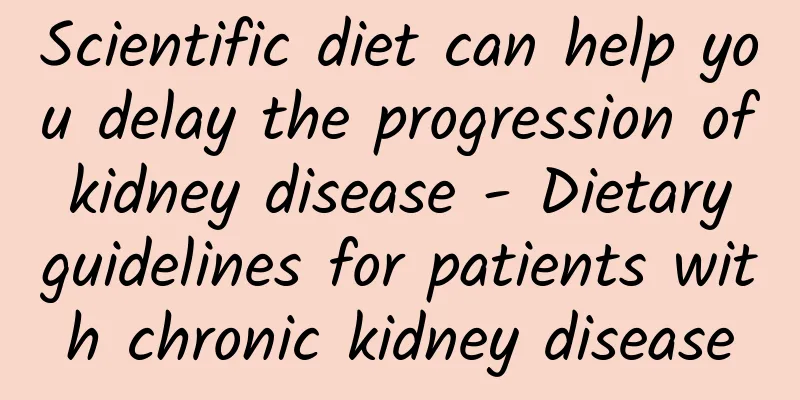Scientific diet can help you delay the progression of kidney disease - Dietary guidelines for patients with chronic kidney disease

|
[Editor's Note] In order to study and implement General Secretary Xi Jinping's important expositions on traditional Chinese medicine, and implement the spirit of the two sessions of "promoting the inheritance and innovation of traditional Chinese medicine, and strengthening the construction of traditional Chinese medicine's advantageous specialties", our association will organize science popularization studios of famous doctors and experts to carry out a series of science popularization work around the International Day for Disease Prevention and Control, to meet the public's demand for health science popularization and contribute to the construction of a healthy China. 【World Kidney Day related introduction】 In view of the increasing incidence of chronic kidney disease worldwide and the general lack of knowledge among the public about the prevention and treatment of the disease, the International Society of Nephrology and the International Federation of Kidney Foundations jointly proposed to designate the second Thursday of March each year as World Kidney Day starting from 2006. March 14, 2024 is the 19th World Kidney Day, with the theme: Kidney health for all - promoting medical equality and optimizing medication practices. The Society and Li Ping's famous doctor and famous expert popular science studio edited relevant popular science knowledge with the theme of "World Kidney Day", hoping to spread health knowledge about chronic kidney disease through popular science, improve patients' health literacy, increase awareness of disease risks, strengthen patients' self-management, thereby improving health status and quality of life. As the saying goes, food, clothing, housing and transportation are all essential, and diet plays a very important role in life. All metabolic waste in our body must be excreted through the kidneys, which are filtering organs. You may think that a high-protein diet may increase the burden on the kidneys. So how can we eat to ensure nutrition and delay the progression of kidney disease as much as possible? Let us understand the three major rules and eight points of attention in the diet for kidney disease: 1. Three major disciplines in diet: 1. Diverse food, selected in stages Food diversity is the basis of balanced nutrition. Patients with chronic kidney disease should maintain a rich variety of food, and the types and quantities of food should be selected according to the stages of chronic kidney disease. It is recommended to eat more than 12 types of food per day and more than 25 types per week to ensure a comprehensive and adequate intake of nutrients. It is recommended to eat mainly plant-based foods, with whole grains, potatoes, vegetables, etc. as the main staple foods. Fruits and vegetables are rich in vitamins, minerals, and dietary fiber. When eating, pay attention to the water content and potassium content. It is recommended to soak vegetables in water and blanch them before eating. 2. Sufficient energy and balanced nutrition Malnutrition is an important factor that leads to concurrent infection, inflammation, and worsening of cardiovascular and cerebrovascular atherosclerosis. Kidney disease patients should supplement with sufficient calories. The staple food of patients with chronic kidney disease stage 1-2 is mainly cereals and potatoes, one-third of which are coarse grains to ensure the intake of high-quality protein. In chronic kidney disease stage 3-5, when protein is limited, fat and carbohydrates become the main sources of energy. Choose staple foods with low protein content and high energy density. You can also choose aquatic vegetables such as lotus root, water chestnut, etc. to supplement energy and essential amino acids. Chronic kidney disease may also lead to deficiencies in micronutrients, such as B vitamins, vitamin D, iron, zinc, etc. Therefore, nutrition should be assessed regularly and the dietary structure adjusted in a timely manner. 3. Eat regularly and limit alcohol consumption Establishing good living habits, eating regularly, and eating at regular times and in fixed quantities are the basis for maintaining health. Patients with chronic kidney disease should have relatively fixed meal and snack times, avoid being too hungry or too full or overeating, reduce takeout and group meals, and strictly limit processed foods as snacks and snacks. Excessive alcohol and its metabolites are excreted through the kidneys, which can cause direct damage to the kidneys. It also increases the risk of hyperuricemia, diabetes, cardiovascular and cerebrovascular diseases, and indirectly aggravates kidney damage. Therefore, drinking should be limited. 2. Eight points to note in diet: 1. Pay attention to the choice of protein Too much protein is harmful to the body - protein is an essential nutrient for human metabolism. The urea nitrogen generated after protein metabolism must be excreted through the kidneys. Therefore, excessive protein intake will accelerate kidney damage, and insufficient protein intake may lead to malnutrition. Individualized protein intake - How much protein a kidney patient should consume every day is determined by the different stages of chronic kidney disease. For example, for diabetic nephropathy, CKD G1-2, the protein intake is 0.8-0.9g/kg/d; for diabetic nephropathy CKD G3-5, non-dialysis patients, the protein intake is 0.6g/kg/d, and compound α-keto acid preparations are supplemented as appropriate; for hemodialysis or peritoneal dialysis patients, the protein intake is 1.0-1.2g/kg/d. Multiply the ideal body weight by the amount of protein that should be consumed per kilogram of body weight per day, which is the amount of protein that the patient should consume throughout the day. Kidney patients should prepare a "high-quality low-protein diet" recipe that suits them under the guidance of a professional doctor. High-quality protein is the first choice - high-quality protein is easy to be digested and absorbed by the human body, has high utilization after absorption, and contains a lot of essential amino acids. It includes meat, fish, eggs, milk, soybeans, etc. Other foods such as rice and flour also contain protein, but they are not high-quality proteins. If the total amount of protein intake for the whole day does not exceed the limit, try to choose to eat high-quality protein. Choose staple foods with less protein - Rice and flour are mainly carbohydrates, but also contain non-high-quality protein, so patients are advised to replace some staple foods with high-starch foods such as yam, potato, taro, sweet potato, tapioca, vermicelli, vermicelli, and rice noodle skin. Low-protein rice and flour available on the market are specially processed rice and flour with reduced protein content. They can be used to steam dough, steamed flower rolls, steamed buns, etc. This can ensure the supply of calories without increasing the intake of non-high-quality protein. 2. Pay attention to potassium regulation High potassium and low potassium are both dangerous - 80% of the potassium ingested by the body is excreted by the kidneys. Patients with renal insufficiency have a reduced ability to regulate potassium and may develop hyperkalemia. Severe hyperkalemia can lead to a slow heart rate, even ventricular fibrillation, and cardiac arrest. Low potassium (diuretic use, insufficient food intake) can also occur in patients with kidney disease, and low potassium can also cause fatal arrhythmias and endanger life. The potassium content of food should be understood : Cereals and tubers with high potassium content include buckwheat noodles, sorghum rice, oats, potatoes, soybeans, peas, mung beans, kidney beans, broad beans, black beans, etc. Vegetables with high potassium content include fungus, seaweed, bamboo shoots, wild rice stem, spinach, bitter melon, mushrooms, lotus roots, etc. Fruits with high potassium content include bananas, oranges, durian, hawthorn, dragon fruit, and cherries. Nuts (peanuts, walnuts, black sesame) and dried fruits (raisins, dried apricots, dried longans, etc.) generally contain high potassium. 3. Pay attention to the appropriate amount of water For those without edema and with normal urine volume, the daily water intake is 1500-1700ml. For those with edema or reduced urine volume, the water intake should be planned according to the urine volume of the previous day or the amount of dialysis dehydration, and the intake should be based on the output. Under the guidance of a doctor, a low-salt diet should be implemented, and foods with high water content should be reduced to avoid worsening edema. 4. Pay attention to a low-sodium diet Less salt is good to know - controlling salt intake is good for improving blood pressure, reducing proteinuria and edema in patients with kidney disease. It is recommended that patients with chronic kidney disease should not consume more than 5g of salt per day. For patients with edema, a lower salt intake may be required. In addition to salt, condiments such as soy sauce, monosodium glutamate, chicken essence, and preserved foods such as sausages and ham also contain a lot of sodium. Salt control skills are very necessary - ① Add salt when the dish is out of the pot ② Use onion, ginger, garlic, tomato juice, vinegar, pepper juice, etc. instead of salt for seasoning ③ Use low-sodium salt or low-sodium soy sauce instead of ordinary salt and soy sauce (note that low-sodium salt has a high potassium content) ④ Choose one meal a day without salty foods. 5. Pay attention to calcium intake Calcium supplementation needs to prevent interference - hypocalcemia and osteoporosis are common complications of chronic kidney disease. Various dairy products and meats are high in calcium and have high absorption rates. It should be noted that drinking a lot of carbonated drinks, coffee, and strong tea will affect calcium absorption, and smoking and drinking will interfere with the metabolism of vitamin D. Moreover, the highest content of bone soup is fat and purine, and calcium is usually insoluble in the soup, so it is necessary to correct the misconception of drinking bone soup to supplement calcium. 6. Pay attention to phosphorus intake Calcium and phosphoprotein often coexist - hyperphosphatemia is common in chronic kidney disease, so it is necessary to limit phosphorus intake in food. Phosphorus usually coexists with protein. Generally speaking, foods high in phosphorus are mainly concentrated in soy products, dairy products, nuts, animal liver, beverages, and processed foods. Processed foods should be avoided - compared with phosphorus from animal sources, the intestines have a low absorption and utilization of phosphorus from plant sources, while the phosphorus in food additives is almost completely absorbed by the human body. Therefore, special attention should be paid to avoid consuming cola, herbal tea, cheese, instant noodles, fast food, ham, eight-treasure porridge, milk powder, etc. 7. Pay attention to a low-purine diet Purine should be low rather than high - Uric acid is a product of purine metabolism. About 20% of the purine in the human body comes from food intake. Therefore, if patients with chronic kidney disease have hyperuricemia, they should try to eat a low-purine diet. It is not advisable to eat seafood, broth, animal offal, beer and other high-purine foods. It is not advisable to eat sugary drinks and some fruits with high fructose content, such as apples, oranges, longans, lychees, grapefruits, persimmons and pomegranates. It is not advisable to eat too much mushrooms, straw mushrooms, asparagus, red meat, such as beef, lamb, pork, etc., whose purine content is higher than white meat (chicken, duck, goose and freshwater fish). Cooking methods should be referred to - fresh meat should be eaten as much as possible. Cured, pickled or smoked meat has high purine and salt content and is not suitable for patients. When cooking, it is recommended to boil and discard the soup. Deep-frying, frying, braising or hot pot cooking methods are not recommended. When using condiments, avoid using too much salt, sugar and spices. 8. Pay attention to fat intake Good and bad fats should be clear - fat has the highest production capacity among the three major nutrients and is usually added to the diet of chronic kidney disease to provide sufficient calories. Fats can be divided into good and bad. Good fats include olive oil, rapeseed oil, corn oil, peanut oil, etc., which are rich in "monounsaturated fatty acids"; as well as sunflower oil, soybean oil, marine fish oil, etc., which are rich in "polyunsaturated fatty acids". Bad fats are animal fats and artificial fats that contain a lot of "trans fatty acids", such as shortening and non-dairy creamer. It is recommended that patients with chronic kidney disease should not consume more than 25-40g of cooking oil, try to avoid bad fats, and eat good fats in moderation. The above are the details that need to be paid attention to in the diet of chronic kidney disease. We hope that through our introduction, kidney patients will pay attention to the importance of reasonable intake of protein, fat, water, calcium, phosphorus, potassium, sodium, purine, etc., and help kidney patients choose a scientific diet and live a healthy and high-quality life. Source: Members of the Li Ping Famous Doctor and Expert Science Studio of the Chinese Association of Traditional Chinese Medicine, Wang Yanmei and Wu Xiai Reviewer: Li Ping, Director of the Science Popularization Studio of Famous Doctors and Experts of the Chinese Association of Traditional Chinese Medicine, Chief Physician of the China-Japan Friendship Hospital About the Author Wang Yanmei, master's degree, doctor of Chinese medicine. Attending physician of the Department of Diabetes of Integrated Chinese and Western Medicine. Young member of the Chinese Medicine Constitution Branch of the Chinese Association of Traditional Chinese Medicine. Professional expertise: 1. Diagnosis and treatment of diabetes and chronic complications of diabetes (diabetic nephropathy, diabetic cardiovascular and cerebrovascular complications, diabetic peripheral neuropathy) with integrated Chinese and Western medicine. 2. Diagnosis and treatment of metabolic syndrome (obesity, hypertension, hyperlipidemia, hyperuricemia) with integrated Chinese and Western medicine. 3. Diagnosis and treatment of endocrine diseases such as thyroid dysfunction, thyroid nodules, irregular menstruation, acne, insomnia, etc. with Chinese medicine. Wu Xiai, female, PhD in TCM Internal Medicine, inheritor of the sixth batch of academic experience of senior TCM experts of the State Administration of Traditional Chinese Medicine, associate chief physician, deputy director of the Department of Integrated Traditional Chinese and Western Medicine Diabetes of the China-Japan Friendship Hospital. Her main research direction is the diagnosis and treatment of diabetes and its chronic complications, chronic kidney disease and its complications with integrated traditional Chinese and Western medicine. Audit Expert Profile Li Ping, chief physician, doctoral supervisor, Qihuang scholar, famous Chinese medicine doctor in the capital. He once studied under Professor Shi Zhensheng, a famous Chinese medicine nephrologist in China, and is the head of the popular science studio of famous doctors and experts of the Chinese Association of Traditional Chinese Medicine . He is good at using traditional Chinese medicine prescriptions to treat exogenous fever, recurrent oral ulcers and complicated urinary tract infections. He specializes in the treatment of difficult kidney diseases such as chronic nephritis, chronic renal failure and diabetic nephropathy with the combination of Chinese and Western medicine. |
Recommend
If you want to supplement calcium with bone soup, you need to drink at least 100 bowls a day
"After 100 days of injury, drink a bowl of b...
What to do if the vulva is red and swollen during pregnancy
When a woman is pregnant, various parts of her bo...
How to prevent aging after menopause
Amenorrhea means that women's menstruation ha...
Can I soak my feet during menstruation?
During menstruation, women are prone to dysmenorr...
What department should I go to for dysmenorrhea
It can be said that most women will experience sy...
What fish can be caught after the winter solstice? What should be paid attention to when fishing during the winter solstice?
We all know that fishing is a common leisure acti...
Everyone has an organ in their body that can generate electricity...
What does a broken heart look like? It turns out ...
What gynecological diseases can potassium permanganate treat?
Many women in life are troubled by gynecological ...
Reasons for less milk supply at ten months
Nowadays, many parents often extend breastfeeding...
These Chinese medicines can replenish blood, replenish qi and remove freckles, you must know!
Modern women are under increasing pressure in lif...
What is the normal estrogen level?
After women enter puberty, their bodies will secr...
What color is rose tea? Tips on making rose tea
Rose is a good food that can be used as both medi...
Which department should I go to for blood test for pregnancy
If you want to have a blood test during pregnancy...
How long does it take to have a uterine curettage without bleeding?
When an unexpected pregnancy occurs, the most int...









